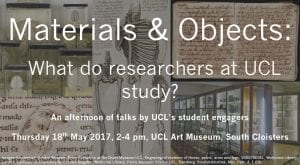Materials and Objects: The Secrets behind our Research
By Josie Mills, on 16 May 2017
Materials and Objects, an afternoon of short talks by UCL’s student engagers, will be taking place on Thursday 18th May 2017, UCL Art Museum 2-4pm
Our next event ‘Materials and Objects’ is just a few days away and I thought this would be a good opportunity to chat a little bit about the event and our work as research engagers in general! This Thursday an afternoon of short talks will be given by UCL PhD researchers on a wide variety of topics, with a focus on the materials and objects that underlie each of our research areas. How this is interpreted varies from discipline to discipline but we all directly deal with materials and objects—or the systems used to understand, archive, and process them—whether it’s studying how objects like diaries and brains can be created, or interpreting new layers of meaning from materials like medieval manuscripts. As a team we employ a huge variety of different techniques, although we often surprise ourselves by the degree of overlap even with our disparate time frames and subject materials!
The event itself is being hosted by UCL Art Museum—one of the museums we actively engage in—as our work reflects themes and pieces from the space itself. In fact, as research engagers, you can usually find one of us in the three museums on campus: the Art Museum, the Grant Museum or the Petrie Museum of Egyptian Archaeology. Depending on which museum we’re engaging in, different aspects of our research intersects with the displays.
As an archaeologist who focuses on prehistoric stone tools when I’m in the Petrie Museum I usually talk to people about the flint artefacts that you may not necessarily associate with the Ancient Egyptians. In the Art Museum I mainly focus on discussing landscape as my research also deals with reconstructing ancient landscape use.
Funnily enough last Tuesday in the Grant Museum someone asked me ‘So how do you relate rocks to this?’ as they gestured widely indicating the menagerie of fauna, both skeletal and preserved, surrounding us. I hastily indicated the Neanderthal skull cast around the corner and we chatted about Ice Age megafauna and hunting. We also talked about research in general and how, although he had studied medieval history, many of the processes that we use to get to the end goal are similar across all disciplines be it archaeological or neuroscience.

The head of a flint snake (UC. 15171), which I often point out to people in the Petrie Museum, it is part of a display of flint animals including cows, dogs and birds! This demonstrates flint’s use as non-practical material and highlights its importance in Ancient Egypt! (photo by author)
That pretty much sums up the core of being a research engager, attempting to make what we do – which may at first glance sound niche – relevant and interesting to visitors of UCL Museums and UCL in general. In turn we benefit from having other opinions about our research as well, which can sometimes seem like a solo journey!
So come and see for yourself this Thursday—expect science, art, cake, and the odd Neanderthal!
Grab a free ticket here:
https://www.ucl.ac.uk/culture/events/materials-and-objects-what-do-researchers-ucl-study
 Close
Close


